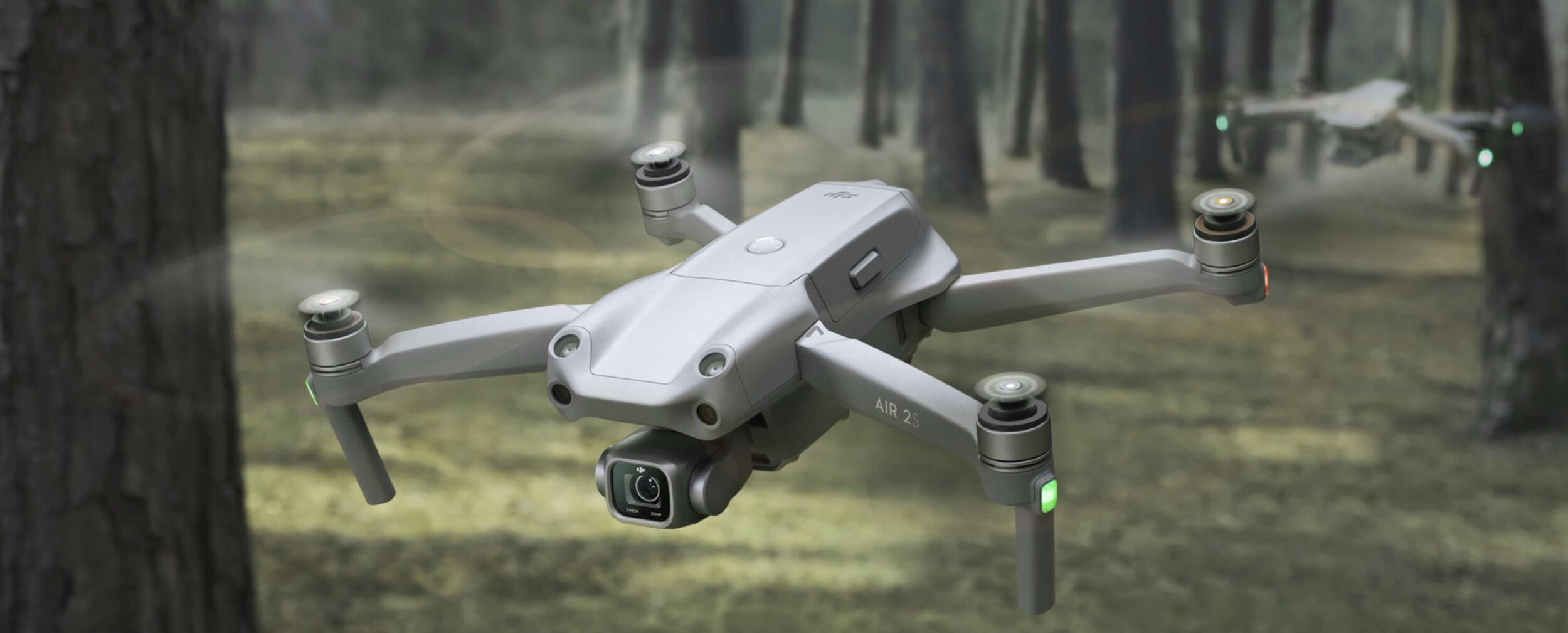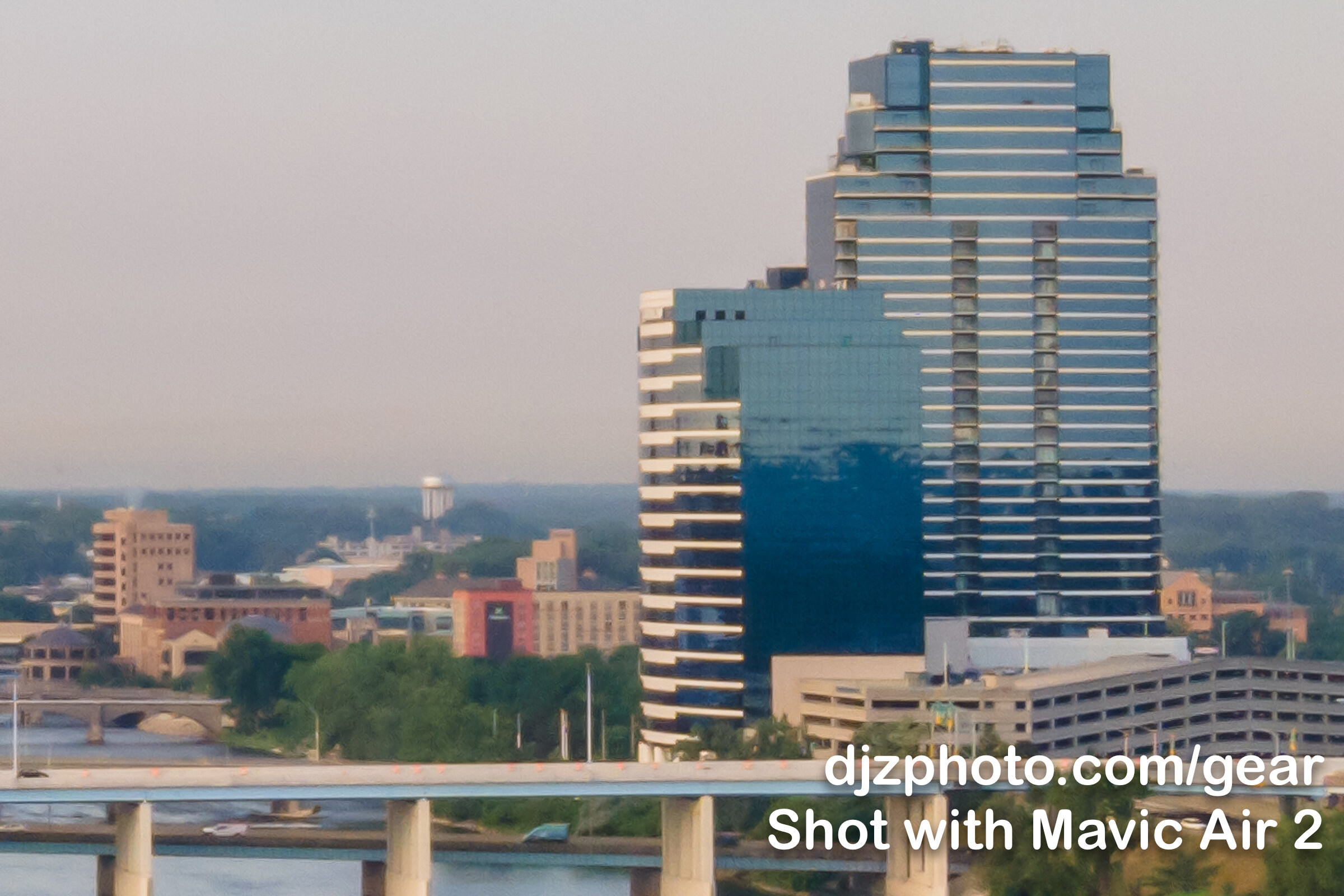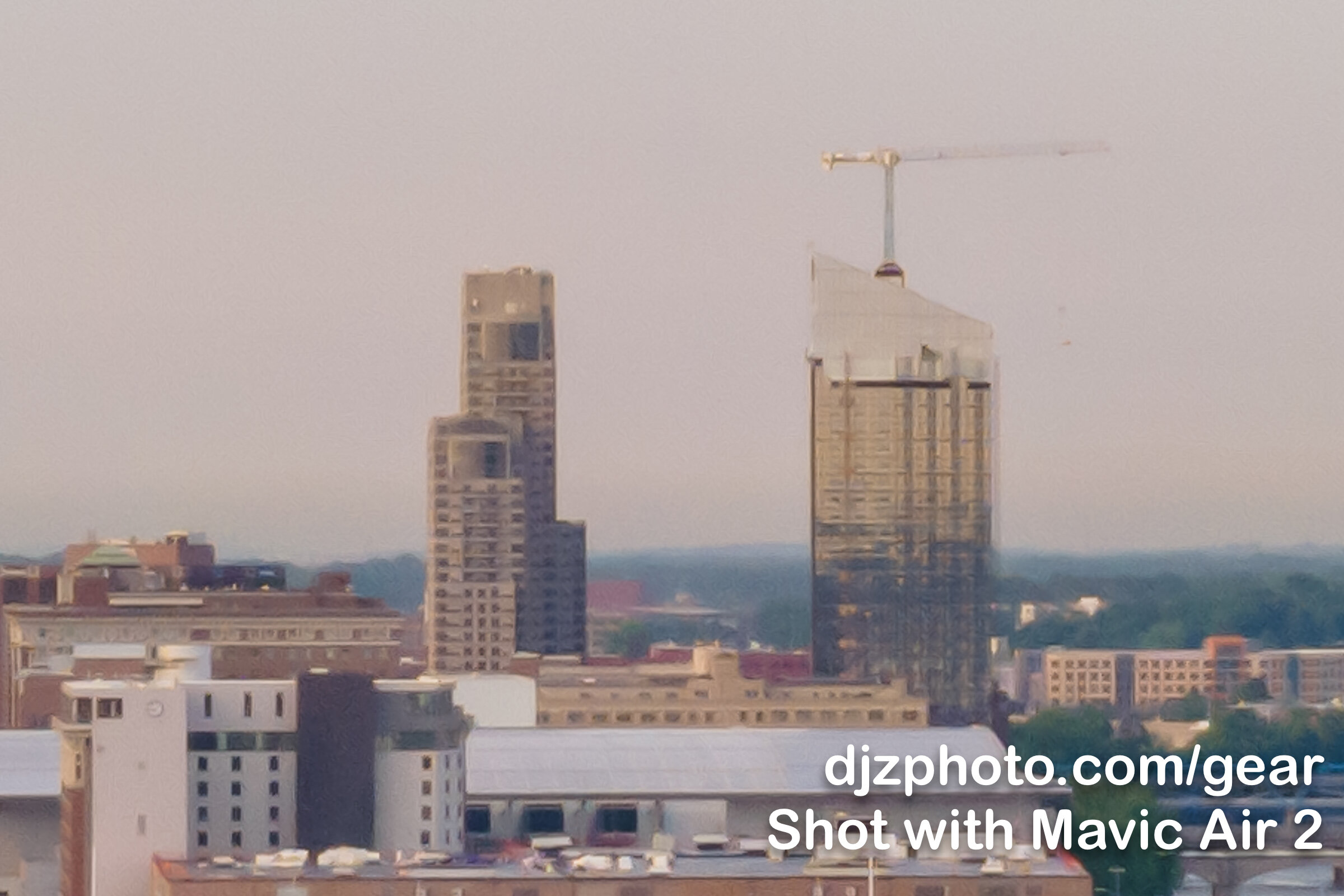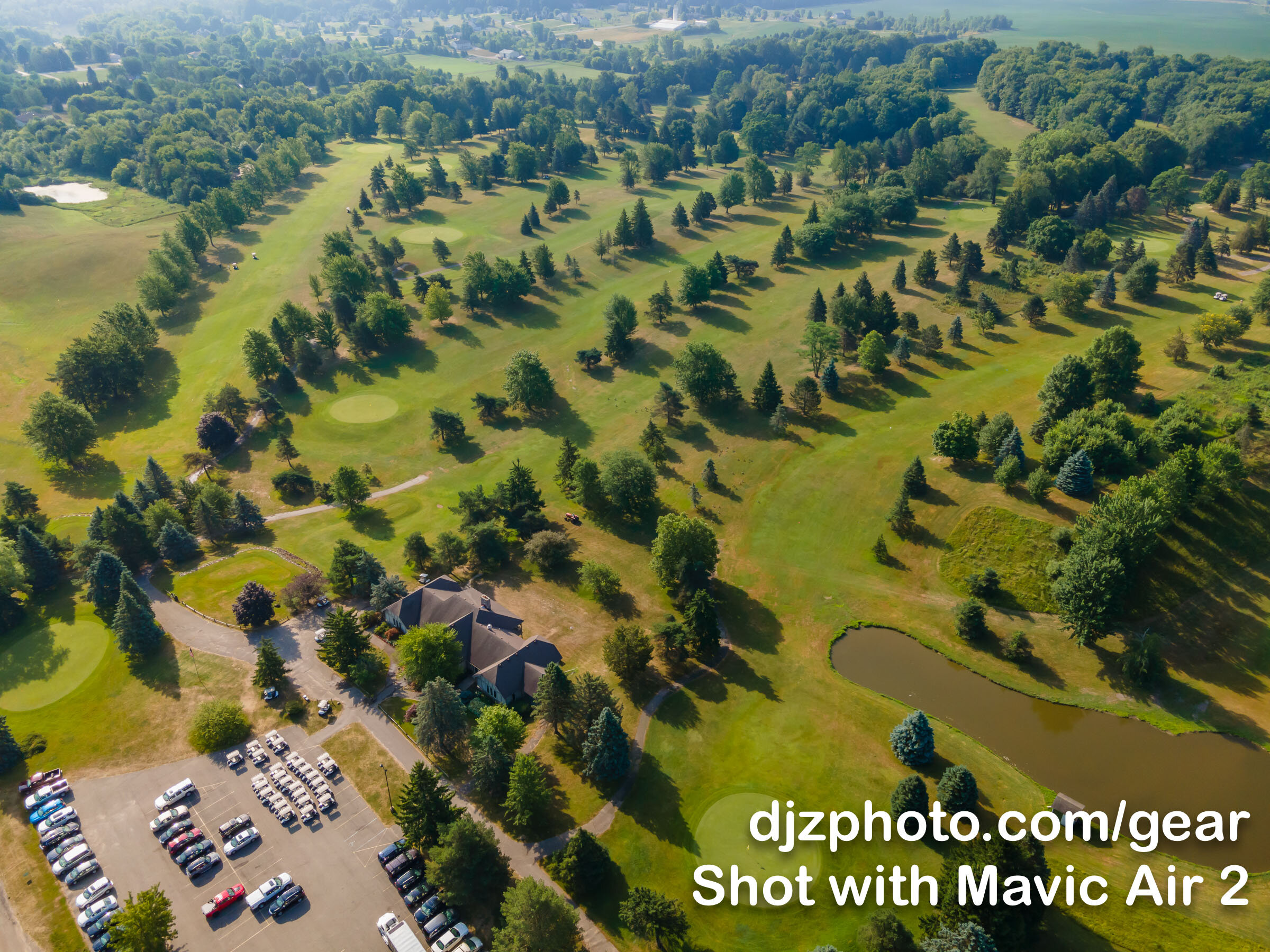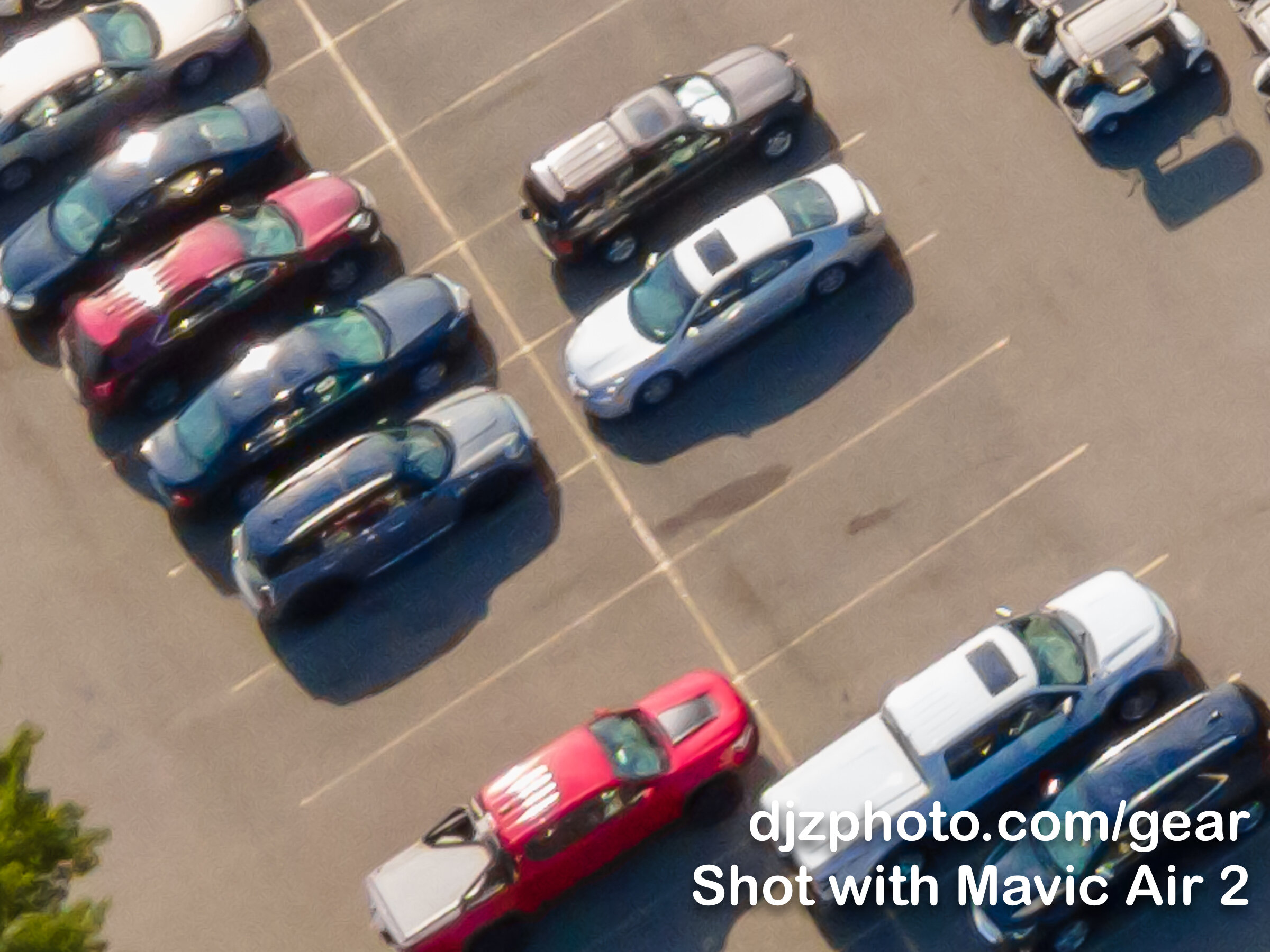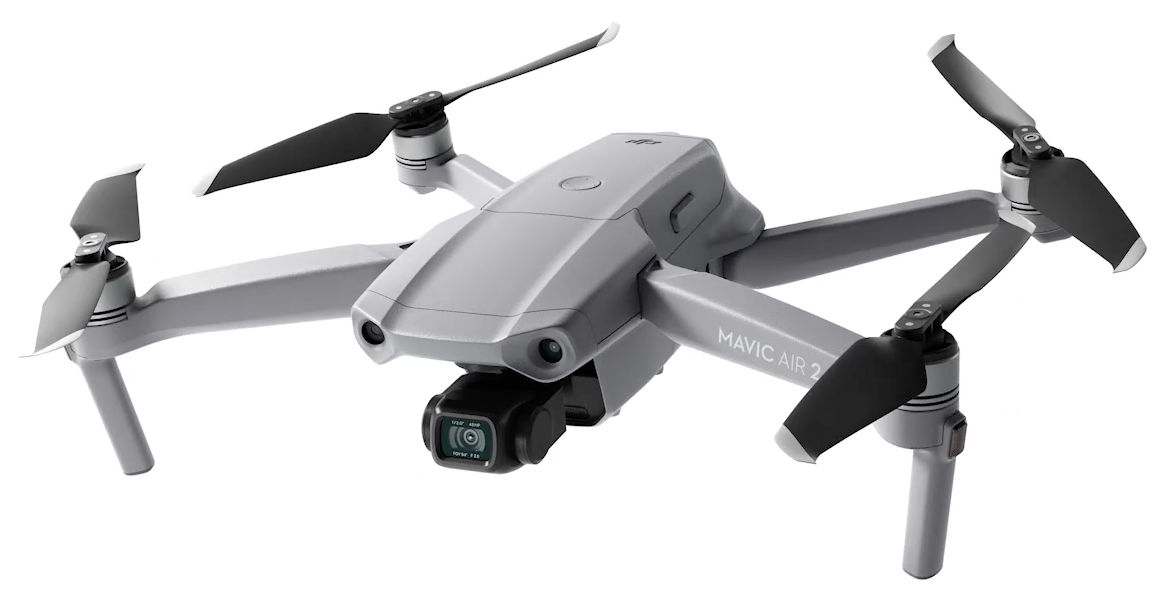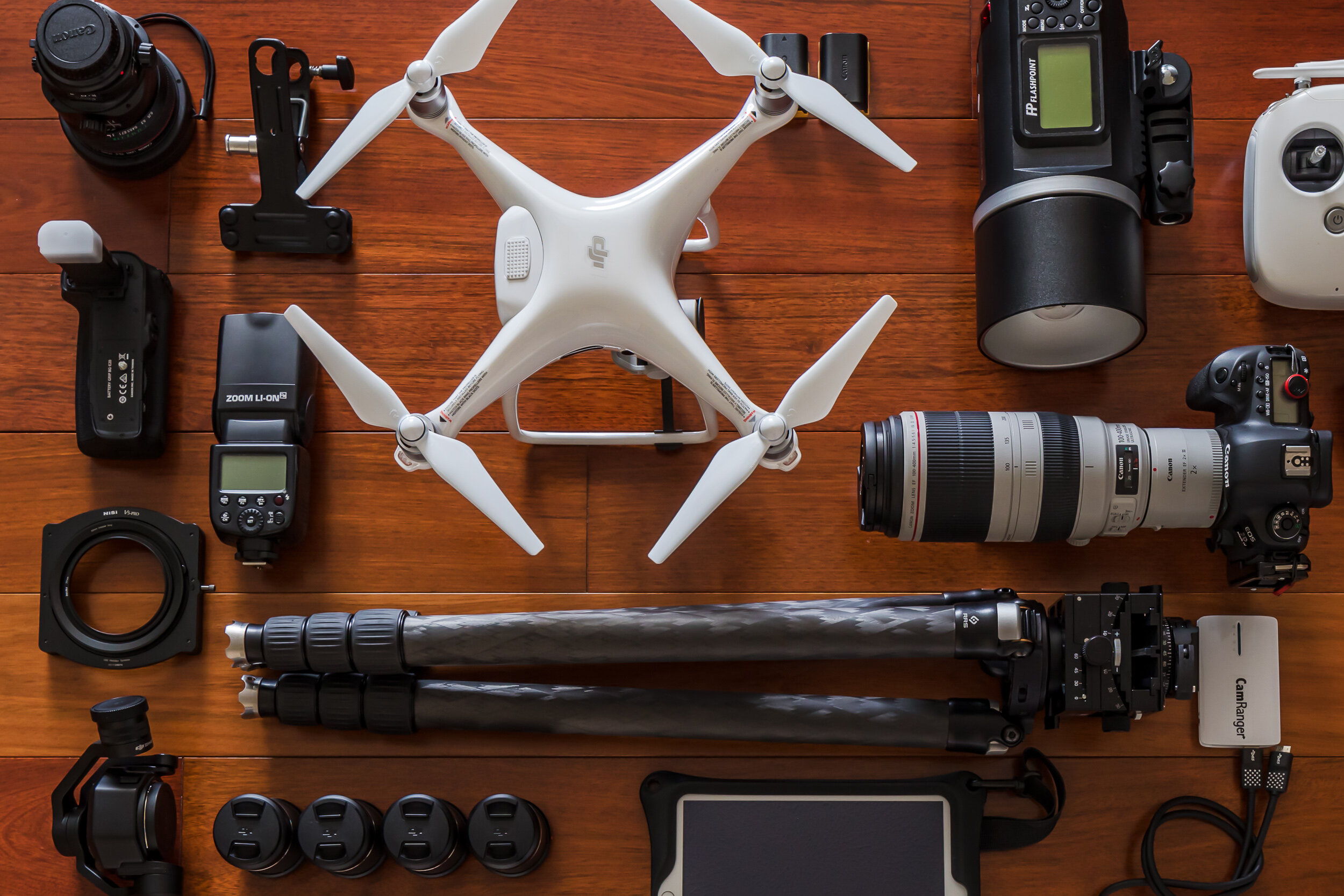
Camera & Drone Gear Blog
Info, Reviews, Comparisons, & News
DJI Officially Unveils the DJI Air 2S (Previously Known on Rumor Sites as the Mavic Air 2S)
DJI today has officially announced the DJI Air 2S, an updated version of the Mavic Air 2. It is the same compact size as the Mavic Air 2, and is only slightly heavier (595g vs 570g).
I am thrilled to see they upgraded the camera sensor size to 1-inch like the Phantom 4 Pro and the Mavic 2 Pro. It actually shoots higher resolution video than any of their other sub-$2,000 drones, using every pixel of the sensor to shoot 5.4K video! Barring the much larger, heavier, more expensive professional/enterprise drones like the Inspire 2 and Matrice series, this drone looks to be their new flagship (for now).
See Also: Is the DJI Air 2S Fly More Combo a Good Value vs. the Basic Package?
See Also: DJI Air 2S Review: Has DJI Finally Created a Superior Successor to the Phantom 4 Pro??
See Also: Pelican 1400 Protector Case - A Customizable Waterproof Case for DJI Mavic Series Drones
This page contains links to products, so if you find this site useful and use a link to make a purchase, I’ll get a small commission. As an Amazon Associate I earn from qualifying purchases. Enjoy!
DJI today has officially announced the DJI Air 2S, an updated version of the Mavic Air 2. It is the same compact size as the Mavic Air 2, and is only slightly heavier (595g vs 570g).
I am thrilled to see they upgraded the camera sensor size to 1-inch like the Phantom 4 Pro and the Mavic 2 Pro. It actually shoots higher resolution video than any of their other sub-$2,000 drones, using every (horizontal) pixel of the sensor to shoot 5.4K video! Barring the much larger, heavier, more expensive professional/enterprise drones like the Inspire 2 and Matrice series, this drone looks to be their new flagship (for now). Given this development, I’ll be interested to see where they end up going with the Mavic series. Will there be a Mavic 3? Time will tell.
In perusing through the specs page for the DJI Air 2S I noticed they’ve changed the camera lens to a 22mm (full-frame equivalent) with an 88-degree field of view, compared with 24mm/84-degree lens on the Mavic Air 2 & Phantom 4 Pro. The Mavic 2 Pro camera lens is 28mm with a 77-degree field of view.
I am looking forward to comparing the camera on this new drone to my trusty old Phantom 4 Pro, which previously beat the Mavic Air 2 in my image quality battle.
DJI Air 2S on Amazon
DJI Air 2S Fly More Combo on Amazon
From the DJI Press Release: “DJI Air 2S Melds Incredible Image Quality With Unmatched Flight Performance
Added Obstacle Sensors Improve Autonomous Flying, While The 1” Sensor Offers 20-Megapixel Photos and 5.4K Video
DJI, the global leader in civilian drones and creative camera technology, today sets a new benchmark for high-grade flight performance and incredible imagery with the new DJI Air 2S. This portable camera drone is an all-in-one solution, offering robust flight performance, state-of-the-art camera upgrades and high-grade preprogrammed content creation tools.
“Every creator remembers what it felt like to fly a drone for the first time, and they’ll feel the same sense of wonder and possibility when they first experience DJI Air 2S’s unparalleled mix of astonishing flight capability and gripping image quality,” said Ferdinand Wolf, Creative Director, DJI Europe. “DJI Air 2S is a wish list come to life for everyone who demands more from a drone, showcasing upgrades that truly elevate the system into a highly versatile drone. From content creators, to drone enthusiasts and travelers, we are confident that a lot of people will be excited about this drone.”
The DJI Air 2S is the first drone of its size to capture 20-megapixel still images or video in 5.4K with a new one-inch sensor that was previously available only on larger, less agile drones. DJI continues to enable the effortless creation of imaginative content with the new MasterShots feature. This advanced feature uses automatic flight path planning to set the drone’s course while recording video. Upon completion of the flight, DJI Air 2S automatically merges the footage under one theme to create an eye-catching video.
DJI Air 2S’s 31 minutes of maximum flight time and four-way directional obstacle sensors let the pilot focus on the shot while the drone’s safety systems warn when obstacles are getting close. APAS 4.0 is the most advanced autopilot system on any DJI drone and when turned on, seamlessly maneuvers around objects autonomously. O3, DJI’s third iteration of OcuSync, brings the most reliable transmission technology in the drone market to this portable, foldable drone so users know their connection is stable. The upgraded FocusTrack mode includes a suite of programmed modes like Spotlight 2.0, ActiveTrack 4.0 and Point of Interest 3.0 that easily mimic the focus, control and movement of a professional video operator.
An All-In-One Tool for All Your Content Capturing Needs
Expand your creative vision and capture high-grade footage using a new one-inch sensor capable of recording 20-megapixel still images, 5.4K video at 30fps or 4K at 60fps and 150Mbps. The one-inch sensor is larger than the sensor on the original Mavic Air 2 and offers a larger pixel size of 2.4μm, capturing more information and detail for better photos and videos. Get closer to the subject without moving the drone using a new digital zoom that supports 4X zoom at 4K 30fps, 6X at 2.7K 30fps, 4X at 2.7K 60fps, 6X at 1080P 60fps and 8X at 1080P 30fps. DJI’s renowned three-axis mechanical gimbal smooths out footage for professional-level quality and 8 GB of internal storage have been added. Users can choose to record in H264 or H265, depending on their preferences for image detail and storage capacity and can also choose from three video color profiles, Normal (8 bit), D-Log (10 bit) or HLG (10 bit) to match their video needs.
In addition to standard photo options like Timed Photo, AEB and Panoramas, DJI Air 2S’s SmartPhoto mode records 20-megapixel photos using advanced scene analysis and deep learning to automatically choose the best of three options that will create the most visually appealing image for you, including HDR, Hyperlight and Scene Recognition. HDR modes merge several images together for a vibrant scene while Hyperlight is designed for low-light scenarios and Scene Recognition can identify several common settings and apply camera adjustments to capture photos that pop.
Pre-Programmed Modes for Pro-Level Footage
The DJI Air 2S has the most programmed flight modes and image capture modes of any DJI drone of its size. These creative options include:
MasterShots: Professional-level aerial footage has never been easier. After activating MasterShots, the drone will autonomously plan a flight path, choose from three different image capture modes, including Proximity, Portrait or Landscape, and start recording classic aerial footage. Pilots can choose different themes and the DJI Fly app will generate a unique video that’s ready to be shared with the world.
FocusTrack: Focus on the scene and let DJI Air 2S do the hard work for you. Select your subject by drawing a square around it on your mobile device, then choose from Point of Interest 3.0, an autonomous flight path around the subject; ActiveTrack 4.0, a tool that seamlessly tracks the subject and keeps it in the frame; or Spotlight 2.0, where the drone movement is controlled by the pilot while it locks the subject into the frame.
QuickShots: A staple DJI feature, QuickShot modes include Rocket, Circle, Dronie, Helix, Boomerang and Asteroid.
Hyperlapse: See the world sped up from the air and in motion with the Hyperlapse option in resolution up to 4K. Content captured in 4K resolution and lower can apply digital stabilization for an added layer of smoothness.
Safe and Intuitive Flight Operation in an Ultra-Portable Drone
DJI Air 2S uses four high-grade antennas and the latest version of DJI’s proprietary OcuSync transmission tech, O3, to deliver a stable feed at a maximum distance of 12km, even in areas with a high number of signals. A maximum 31 minutes in the air gives pilots more time to capture visually appealing footage while four-way sensors help reduce the risk of collision. The newly upgraded front, rear, bottom and top obstacle sensors incorporate binocular zooming technology to recognize incoming objects from further away at faster speeds.
DJI Air 2S uses the latest and most advanced version of Advanced Pilot Assistance System (APAS) 4.0, which allows the drone to autonomously and seamlessly maneuver around, under and over obstacles. While flying at normal speeds, the newly improved APAS 4.0 offers a wider field-of-view to detect obstacles compared to previous versions. If pilots are flying at higher speeds, as the angle of the drone pitches forward more and the newly added upward obstacle sensor plays a critical part in assisting obstacle detection. As with DJI’s latest drone models, the DJI Air 2S’s AirSense system warns drone pilots of nearby airplanes and helicopters transmitting ADS-B signals, so the drone can be quickly moved to a safer location. Other standard DJI safety features of DJI Air 2S include an improved Return-To-Home (RTH) feature, which can bring a drone back to its launch point if it loses contact with the controller or reaches a critically low battery level, and the GEO 2.0 geofencing system to advise pilots of sensitive locations and help them automatically keep away from high-risk areas such as airports. DJI Air 2S uses the latest version of the DJI Fly app, which features a wealth of educational information and tutorials to get new pilots up in the air quickly.
DJI Care Refresh
DJI Care Refresh is now available for DJI Air 2S, covering various accidents, such as water damage, collisions, flyaway, etc. For an additional charge, DJI Care Refresh offers up to two replacement units within one year, including coverage for one flyaway incident. The two-year plan provides three replacement units in two years, including coverage for up to two flyaway incidents and an extension of the original warranty period by one year (extension durations vary by region). Receive your replacement even sooner with DJI Care Refresh Express. DJI Care Refresh also includes exclusive after-sales support and free two-way shipping.
Price and Availability
DJI Air 2S is available for purchase today from store.dji.com and from authorized retail partners in several configurations. The standard combo retails for $999 and includes the drone, remote controller, one battery and all the cables and parts needed to get into the air. The Fly More Combo retails for $1,299 includes everything from the standard combo with the addition of 2 batteries for a total of 3, ND filters, a charging hub and a shoulder bag.”
Megapixels vs. Sensor Size: Can the Mavic Air 2 Beat the Phantom 4 Pro?
I got ahold of a Mavic Air 2, and I just had to know how its higher resolution images compared to the 20 megapixel Phantom 4 Pro and its 13.2 x 8.8mm sensor. If the sensor sizes were the same, I would expect the sensor with more pixels to be the winner. But how do they compare when the higher resolution photos are from a much smaller sensor (6.4 x 4.8mm)? Let’s take a look.
See Also: DJI Drone Sensor Size Comparison Page
See Also: DJI Air 2S Review: Has DJI Finally Created a Superior Successor to the Phantom 4 Pro??
See Also: DJI Mavic 3 vs. DJI Air 2S - Image Quality Tests, Comparison and Review
See Also: Pelican 1400 Protector Case - A Customizable Waterproof Case for DJI Mavic Series Drones
( This page contains links to products, so if you find this site useful and use a link to make a purchase, I’ll get a small commission. As an Amazon Associate I earn from qualifying purchases. Thanks!)
When DJI announced the Mavic Air 2, I was a bit surprised at its max photo resolution of 8000x6000. Why, that’s 48 megapixels from a 6.4 x 4.8mm sensor! Considering all their more expensive drones with larger sensors produce images around 20 megapixels, what is going on with the camera on this new little drone?
I have had a Phantom 4 Pro for a few years, and they haven’t really released a sub-$2,000 drone with a better camera (as of July 2020). The Mavic 2 Pro is the closest to the Phantom 4 Pro with the same sensor size and photo resolution (though it is 28mm instead of the Phantom 4 Pro’s 24mm), but the Phantom 4 Pro from November 2016 still has better video specs than the Mavic 2 Pro.
2021 Update: DJI has now released the DJI Air 2S (also known as the Mavic Air 2S) which is a MUCH better drone than the Mavic Air 2. See my other article that tests the image quality of the DJI Air 2S vs. the Phantom 4 Pro.
I got ahold of a Mavic Air 2, and I just had to know how its higher resolution images compared to the 20 megapixel Phantom 4 Pro and its 13.2 x 8.8mm sensor. If the sensor sizes were the same, I would expect the sensor with more pixels to be the winner. But how do they compare when the higher resolution photos are from a much smaller sensor? Let’s take a look.
For the first shot, I took both drones to a lake:
The first thing I noticed is the Mavic Air 2’s max resolution is a 4x3 ratio (like a smartphone), whereas the more expensive drones (and most professional cameras) have a 3x2 ratio.
Both images seem great overall, so let’s take a closer look. For the first crop, I zoomed way in to the house on the little pointe in the upper left corner of the main shot:
The first thing I notice when comparing these two crops is that the Phantom 4 Pro seems to produce a much “cleaner” image with less random noise overall. The Mavic Air 2’s noise has the effect of making the image look like it was painted onto a rough texture when we are zoomed in extremely far. The Phantom 4 Pro (P4P) handles the trees with more sharpness and clarity, and produces less noise on the water. The brown house looks sharper and cleaner on the P4P with a sharper, cleaner, more defined shape.
One area I might give a win to the Mavic Air 2 (MA2) would be the shape of the boats to the right of the house. The MA2 picked up the shape of the boats better than the P4P, though there is a bit of noticeable color fringing.
The next crop is the closer house in the middle of the main images:
Again we can see the P4P produces a cleaner image overall. The window lines are more clearly defined and less noisy, the trees are more natural looking and defined, and the shingles on the roof look more natural and defined.
It is interesting to look at the MA2’s effect on the roof shingles at this extreme level of zoom… it’s almost as if the roof shingles have completely changed into an entirely different pattern.
That’s not to say the MA2 lost in every way… I think it did a better job of defining the curved line where the grass meets the cement, and a nicer job with the curved steps on the back patio area. I also think the MA2 did a better job defining the patio furniture in the upper left corner of this crop, and some of the roof lines seem sharper and more defined.
The last crop at the lake will be the boat, lift, and dock to the left of the houses in the middle of the main images:
In the above cropped images the P4P handles the tree leaves much better on the right. The MA2 turns the leaves into odd shapes that almost look like a painting. The P4P also did a better job with the water, as you can see the waves & ripples more clearly defined with less noise. The P4P also has less color fringing on the bright areas like the dock and raft.
The MA2 managed to define the shape of the blue boat lift canopy by the dock better, albeit with more noise than the P4P.
For the next setting I went to a park located north of Grand Rapids, Michigan, and took a shot facing south towards the city. Below are the main shots, which seem similar in quality and would be fine to use in most professional projects:
The first crop will be the big building to the right of the river:
The P4P handles the windows and lines on the buildings in this crop much better, with less noise and a more defined & natural look. The buildings and trees in the background are cleaner, sharper, and more defined. The supports under the nearest bridge are also clearer and sharper. Nothing in this crop jumped out at me as looking better on the MA2.
The next crop we can meticulously analyze will be the buildings in the distance to the left of the river:
I will have to give the win to the Phantom 4 Pro! Cleaner, sharper, more defined, more natural looking.
The MA2 does seem to have more sharpness and definition in the construction crane on top of the building though.
The last crop of the city photos will be some of the closer buildings to the left of the river:
In the above crops it seems like the MA2 again pulls a little more definition in the construction cranes. In this image I found it a little tougher to declare a winner, but the P4P does do a better job with the lines and windows on buildings. The P4P also better defines the tree line and buildings in the background near the upper right corner.
For the final photo location, I took the Phantom 4 Pro and the Mavic Air 2 to a golf course on a hot, hazy summer morning:
The first crop will show the area directly in front of the clubhouse:
In the above crop, the MA2 seems to pull more definition if you look at the roofs on the golf carts. But if you look at the shadow of the big tree in the upper left corner, there is a lot more noise in the MA2 image. Also, the P4P continues to handle the appearance of tree leaves much better (especially the tree on the right).
Next, we’ll zoom in to the shed by the little pond:
If you look at the door on the shed and the shingles on the roof, the P4P shows less noise and more definition, contributing to a more natural look. The water is less noisy on the P4P photo, and… this is the last time I will need to say it… but the leaves and grass on the P4P are more defined.
In the last comparison crop, we’ll take a look at the cars in the parking lot. This was a useful crop because it shows a big difference between the two cameras:
Look at all the sun glares on the cars in the MA2’s photo, and you will see… rampant purple! Look at the same glares in the P4P images, and you see the purple fringing is much more controlled. Wherever you have high contrast bright spots, you will often see purple fringing on the MA2.
I cranked the purple defringe amount to 7 under Adobe Lightroom’s manual lens correction panel, and here is the result:
Lightroom was able to correct the purple fringing for the most part, so that’s good that it’s a fairly easy fix.
Conclusion
I wanted to answer the question, “Are megapixels more important than sensor size?” I think we can answer that question with a “probably not.” In this case, the larger sensor on a 2016 Phantom 4 Pro was able to produce generally better images than a smaller sensor from 2020, even though the smaller Mavic Air 2 produces images with more than twice as many pixels. The P4P’s images were cleaner and handled trees, water, and buildings with more clarity & detail.
(I use the phrase “probably not” because the Mavic Air 2 from 2020 would beat a 6 megapixel APS-C camera sensor from 2006, but that’s obviously an extreme comparison)
That being said, whether you use a Phantom 4 Pro, Mavic 2 Pro, or Mavic Air 2, you have a more than capable drone that can capture quality photos & video for a variety of projects in a variety of environments. It will be hard to tell the difference between an image produced on a Mavic Air 2 and a Phantom 4 Pro (other than the aspect ratio) when you’re looking at the entire image. Whether you’re shooting aerial photos for real estate, landscape photography, or for fun, any of these drones are great options! So here are some additional thoughts I have on the Mavic Air 2 that may help you decide if it’s right for you.
Mavic Air 2 Pros
Super compact, easily fits in a camera bag or carry-on bag
Propellers fold in for transportation without detaching them
Relatively quiet and unobtrusive (especially compared with a Phantom 4 Pro)
Costs half as much as a Phantom 4 Pro or Mavic 2 Pro
Super simple remote app for beginners
Produces great images for most purposes
Only with extreme cropping & zooming will you notice a benefit with the larger, more expensive drones
Mavic Air 2 Cons
Bigger & more expensive drones produce moderately better images that may be helpful for larger prints
I feel like it is more likely to be attacked by or accidentally collide with birds than a larger, louder drone (fortunately I haven’t personally confirmed this)
Remote app and camera options might feel too limited and minimal for professionals (you have to use “DJI Fly,” not the “DJI Go” app)
If you want burst shooting or Automatic Exposure Bracketing (AEB), you have to shoot at 12 megapixels, not 48
2021 Update: DJI has now released the DJI Air 2S (also known as the Mavic Air 2S) which is a MUCH better drone than the Mavic Air 2. See my other article that tests the image quality of the DJI Air 2S vs. the Phantom 4 Pro.
Hopefully this article has been helpful. If you want to support more articles like this, feel free to use any link on this page if you make a purchase. Thanks!
Side Note: This test is also relevant when considering how modern day smartphones are starting to have huge megapixel numbers that are higher than the megapixel numbers of large full-frame cameras. Does that mean that smartphones are as good as full-frame cameras?? The answer is “probably not,” because full frame cameras have much larger sensors.
Products Mentioned in this Article on Amazon
DJI Announces the 48-megapixel Mavic Air 2
“Created to make capturing unique, high-quality content from the air simple, fun, and safe, Mavic Air 2 offers flagship capabilities in a compact and easy to use folding drone that features 8K functionality. A larger 1/2” camera sensor offers high-resolution photos and videos to make content stand out, while advanced programmed flight modes, intelligent features and imaging technology make capturing professional-looking content effortless. Pilots can now stay in the sky longer with an enhanced maximum flight time, capture vivid imagery with completely revamped autonomous capabilities, and wholly transform their content with in-app editing features.”
See Also: Pelican 1400 Protector Case - A Customizable Waterproof Case for DJI Mavic Series Drones
This page contains links to products, so if you find this site useful and use a link to make a purchase, I’ll get a small commission. As an Amazon Associate I earn from qualifying purchases. Thanks!
From the DJI Press Release: “DJI, the global leader in civilian drones and aerial imaging technology, today ushers in a new era of aerial creativity with the Mavic Air 2 drone, combining high-grade imaging, intuitive yet advanced flight performance and revolutionary smart and safe technology in the best all-around drone we’ve ever made.
Created to make capturing unique, high-quality content from the air simple, fun, and safe, Mavic Air 2 offers flagship capabilities in a compact and easy to use folding drone that features 8K functionality. A larger 1/2” camera sensor offers high-resolution photos and videos to make content stand out, while advanced programmed flight modes, intelligent features and imaging technology make capturing professional-looking content effortless. Pilots can now stay in the sky longer with an enhanced maximum flight time, capture vivid imagery with completely revamped autonomous capabilities, and wholly transform their content with in-app editing features.
“Mavic Air 2 is another milestone for DJI, demonstrating that our smartest consumer drone does not have to be the largest,” said DJI President Roger Luo. “While the Mavic Air 2 bears all the hallmarks of the Mavic drone family, we had to completely rethink its design and development process. Our goal was to create a drone that offered the best overall experience possible to even the most novice pilot. We hope our drones can help boost creativity and become a fun yet educational experience that can be enjoyed, even at this unprecedented moment in history.”
Robust Imaging Capabilities for Every Type of Creator
The new Mavic Air 2 reimagines how quality content can be captured in a portable, folding drone. No matter the skill level of the pilot, Mavic Air 2’s features and technology are sure to appeal to every creative visionary. Mavic Air 2 is the first drone in the Mavic series to offer 4K video at 60 fps and 120 Mbps. Additionally, users can record unique content using HDR video, 4X Slow Motion in 1080p at 120 fps or 8X Slow Motion in 1080p at 240 fps. Pilots can record 12-megapixel images or choose a new high-resolution 48-megapixel feature that photographs in stunning detail, while a mechanical 3-axis gimbal helps compensate for camera shake to create smooth and stable footage, even in unpredictable scenarios. Taking full advantage of the large Quad Bayer 1/2" sensor, the Mavic Air 2 is the perfect tool to take creativity to the next level with a suite of image capture modes. The newly added SmartPhoto records 12-megapixel photos using advanced scene analysis and deep learning to automatically choose one of three image capture options.
HDR photos: Mavic Air 2 automatically captures seven varying exposures of the same photograph, merging them together to bring out a highly dynamic image.
Hyperlight: Hyperlight is designed for low-light scenarios, taking multiple photographs and merging them to bring out a clear image with less of the noise which usually occurs in low-light scenes.
Scene Recognition: Mavic Air 2 can recognize five categories of scenes including sunsets, blue skies, grass, snow, and trees, then optimize settings to make the photograph pop by bringing out the highest degree of color, detail, and tones.
Unparalleled Flight Performance
Mavic Air 2 completely rebuilt the basics of drone flight to open up the skies for more exploration for everyone who is passionate about drone technology. Despite only weighing as much as a small water bottle at 570 grams, the Mavic Air 2 features new motors, new electronic speed controllers (ESCs), enhanced battery technology and an aerodynamic design to provide a maximum flight time of up to 34 minutes. DJI’s proprietary OcuSync 2.0 transmission technology has been upgraded to deliver an extremely reliable and stable HD video feed from the drone at a maximum distance of 10km. OcuSync 2.0 supports both 2.4GHz and 5.8GHz frequency bands and uses an auto-switching feature to move between the two based on signal strength, while anti-interference technology blocks unwanted signals to keep the video feed clear.
Setting a New Standard for Drone Safety
Mavic Air 2 is equipped with unprecedented new safety features to help make flying as safe as possible. Obstacle sensors on the front and rear of the drone warn pilots when they’re too close to an object and can also be set to stop the drone from moving any closer to avoid collision. Additional sensors and auxiliary lights on the bottom of Mavic Air 2 assist with several functions including smooth, automatic landing even in difficult lighting. Mavic Air 2 also comes equipped with our GEO geofencing solution to help keep drones away from the highest-risk locations, such as busy airports.
Advanced Pilot Assistance System (APAS) 3.0 brings the next level of autonomous flying to DJI drones. When users enable APAS 3.0, as obstacles come into the drone’s path, Mavic Air 2 will create a new path around, under or over the object to avoid collision, giving pilots the confidence to fly in more complex situations while focusing on capturing their ideal images. Using 3D mapping, the updated version aids in smooth transitions and more fluid movements around objects even in highly complex environments.
In accordance with DJI’s industry-leading 10-point Elevating Safety vision published last year, Mavic Air 2 is also DJI’s first consumer drone designed to include AirSense technology, which provides enhanced safety by warning drone pilots of other aircraft nearby. AirSense uses aviation technology known as ADS-B to receive signals from nearby airplanes and helicopters, and displays their location on the drone pilot’s control screen. As these other aircraft approach the drone, AirSense will warn the drone pilot with messages, sounds and vibrations, enhancing the pilot’s awareness and ability to move the drone safely away.
“DJI has an unwavering commitment to enhance drone safety with technology, and Mavic Air 2 implements yet another pioneering safety solution for drone operations,” said DJI Vice President of Policy & Legal Affairs Brendan Schulman. “Our ambitious commitment to installing ADS-B in our new product models means Mavic Air 2 will be the world’s largest single deployment of ADS-B receiver technology, fulfilling and furthering our vision as the industry’s leader on voluntary safety efforts.”
Powerful Intelligent Features
Mavic Air 2 is packed with optimized intelligent features allowing users to quickly and easily record images and video that deserves to be shared with the world. FocusTrack is the most advanced tracking feature on any DJI drone and offers three different capture modes:
ActiveTrack 3.0: Select a subject for Mavic Air 2 to automatically follow. The third iteration of ActiveTrack uses state-of-the-art mapping technology and new flight path algorithms to offer improved subject tracking and obstacle avoidance, along with the ability to quickly re-engage the subject if it temporarily moves behind an object.
Point of Interest 3.0: Set an automated flight path around a specific subject. The updated iteration improves surface recognition to better dynamically track subjects.
Spotlight 2.0: Found in professional DJI drones, Spotlight locks a subject in the frame while the user has free operation of the drone’s movement.
A Hyperlapse feature brings the visual appeal of timelapse but with the added element of the drone physically moving. For the first time, Hyperlapse can be shot in a max resolution of 8K while pilots can choose four flight modes including Free movement, Circle, CourseLock and WayPoints. Pilots can also choose from several pre-programmed flight maneuvers known as QuickShots, which use a 3-axis mechanical gimbal and electronic image stabilization for unmatched video quality. Simply tap the desired mode and Mavic Air 2 will automatically create stunning, cinematic content. Pilots can choose Rocket, Circle, Dronie, Helix, Boomerang or Asteroid.
Intuitive App, Convenient Editing and a Wealth of Accessories
An updated version of the DJI Fly app adds more advanced functionality for Mavic Air 2 while maintaining its user-friendly navigation. New tutorials get users familiarized with the drone and quickly in the air to start capturing compelling footage. Easy to use in-app editing features make the DJI Fly app a one-stop tool to edit and adjust the footage captured. Mavic Air 2 will be supported by a host of additional useful accessories including a shoulder bag, ND filter sets, propeller guards, protective case, tablet holder for the controller and monitor hood.”


